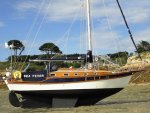Tranona
Well-Known Member
I have not seen the full account of the 90 keels that "fell off", but have difficulty in believing that term as the ISAF data I have seen shows the vast majority are knocked off through grounding or came off poorly designed or constructed race boats. Although I have never seen any data I expect there were many examples of similar keel detachments from wooden boats. As I suggested earlier, it is not bolts that are the problem - it is either the contact with something hard or the supporting structure (or, of course both).Your comments about wood boats do in fact indicate that the bolts themselves are not the problem. In wood boats I believe the bolts were through bolted with a nut under the keel. Wood, which is compressable and malliable to a degree will allow through bolts but GRP would simply crush. Therefore studded bolts threaded into the keel is the solution. Thinking about that for a minute and I wonder what the ultimate difference is, the keel is just one big nut. So why the difference between wood bolted keels staying on while 90 examples of Grp bolted keels fell off?

